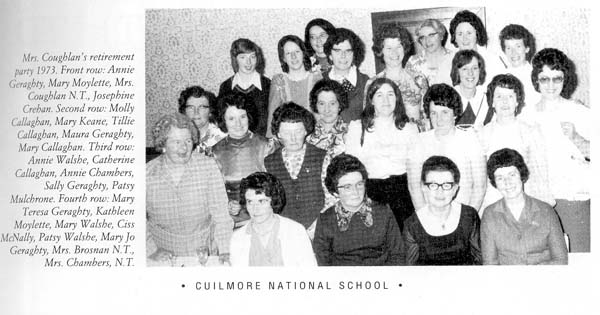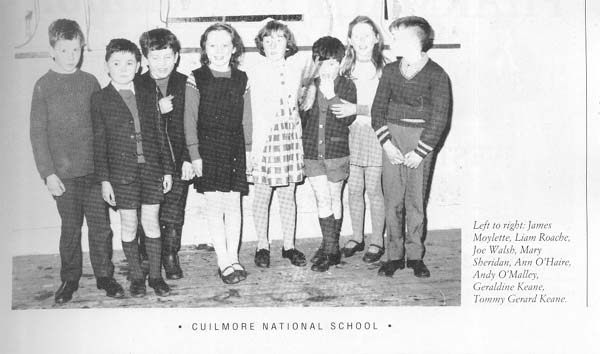
ON the 19th May 1970 I came to Cuilmore National School where I was warmly welcomed by the then Principal -Mrs. Irene Coughlan. At that time, Cuilmore was the newest school in the Parish.
It was the only rural school in the Parish that had flush toilets -albeit they were in an out- building. Built during war years the materials used were of inferior quality, hence it was a very cold and draughty building. During the wet wintry weather the windows rattled incessantly due to their shrunken wooden frames. The furniture in the two classrooms, although adequate, was beginning to show signs of an incipient invasion of wood-worm.
The atmosphere in the school was pleasant and conducive to learning. Bright and eager, the pupils had an avid appetite for knowledge. While Mrs. Coughlan taught the four senior classes, approximately twenty five pupils, I was assigned to the four Junior Classes totalling twenty four children. Time brings changes and we had to move with the times. The New Curriculum had just been launched by the Department of Education, making big demands on the energies of teachers. Traditionally the emphasis was on rote-learning which was subject orientated. A more child- centred education was now being proposed. Ideally each child would be encouraged to develop to his full p~tential by discovering knowledge at his own pace through directed activities planned by the teacher. Teachers had to attend many refresher courses to familiarise themselves with the modem methodology. The main onus, however, was placed on the individual teacher to devise ingenious methods to motivate pupils, often with inadequate facilities.
Although close to retiring age at this time Mrs. Coughlan was active and enthusiastic about implementing these new ideas and the fruits of her endeavours were beginning to show before she left in 1973.

Around this time also there were proposals for rationalisation and new managerial structures for Primary Schools. There was a proposal from the Department of Education to close all the rural schools and bus the children to a Central School in the town -all in the interests of finance! Luckily, although it was on the list of such schools, CuilmoreSchool escaped this social disaster for a rural area.
The new management structures did indeed come into being, giving representation to the parents of the pupils, in the mid seventies. This proved to be a boom to the school. Parents as well as being efficient fund-raisers for the school began to take a keener interest in the education of their offspring. Particularly they became aware of the importance of a child's social development and willingly contributed to making the school a hive of social activity. Dancing, swimming and music lessons and football tournaments were organised and financed by voluntary contributions.
So the changes I have experienced since coming to this school have not contributed to the disintegration of social life in Cuilmore but rather have strengthened it and revitalised a flagging community spirit. 1'd like to pay tribute to the parents and friends of the school for their efforts in holding on to and maintaining their school over the last twenty years. I must also thank the clerical managers of the school who were always available with helpful advice and visited the school frequently. A word of thanks is due also to the Department's inspectors who visited the school from time to time to guide and appraise the work as necessary. Nor must I fail to mention with admiration the teachers who have co-operated with me in promoting the wdfare of the children by giving unstintingly of their gifts and energies: Mrs. Mary Jo Guilfoyle who supported me in some difficult times and brought a new dimension to the School by her experience of teaching in England; the more youthful Breege Chambers currently teaching with me is making a valuable contribution to the School, having come quite recently from the training college. With young teachers like Breege the future seems bright and the school is sure to survive the onslaught of whatever adverse changes in policy by the Department of Education.
Ta an Ghaeilge dar ndoigh sIan agus ag borradh sa scoil. Nf deantar faillf inn. Baineann na leanaf oga an-taithneamh agus sult as na dramaf beaga "Na Tn Mhuca" agus "Na Tn Bhear."
Is soileir bhfuil bua na h-aisteoireachta ag cuid mhaith acu. Mar focal scar guidhim Beannacht De orth6 go leir agus faoi bhrat na Maighdine Muire iad.
